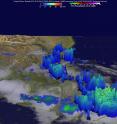NASA sees Tropical Storm Danielle ending over Mexico
Tropical Storm Danielle started weakening after making landfall north of Tuxpan, Mexico on Monday evening at 7 p.m. CDT. As Danielle weakened the low level circulation quickly became disorganized. The Global Precipitation Measurement or GPM mission core satellite looked at the quickly weakening storm's rainfall. The GPM core observatory satellite passed above rapidly weakening Danielle on June 21, 2016 at 0421 UTC (12:21 a.m. EDT).
A rainfall analysis from GPM's Microwave Imager (GMI) and Dual-Frequency Precipitation Radar (DPR) showed that there were only a few areas where rainfall was still falling at moderate to heavy rates. The analysis showed rain falling at a rate of close to 41 mm (1.6 inches) per hour northwest of the approximate center of the tropical depression. The heaviest precipitation of almost 157 mm (6.2 inches) per hour was measured by DPR off the Mexican coast east of Veracruz.
At NASA's Goddard Space Flight Center in Greenbelt, Maryland, GPM's Radar (DPR Ku Band) were used to create a 3-D structure of precipitation within the weakening storm. DPR data showed that storm tops reached maximum heights of about 14.3 km (8.9 miles) in a few storms northwest of the storm's disorganized circulation.
GPM is a joint mission between NASA and the Japanese space agency JAXA.
Danielle dissipated over east central Mexico on June 21.
Source: NASA/Goddard Space Flight Center
Articles on the same topic
- NASA analyzes short-lived Tropical Storm DanielleTue, 21 Jun 2016, 16:10:45 UTC
- Satellites sees Tropical Storm Danielle born along Mexico coastTue, 21 Jun 2016, 16:10:28 UTC
Other sources
- NASA sees Tropical Storm Danielle ending over Mexicofrom PhysorgWed, 22 Jun 2016, 14:31:12 UTC
- NASA analyzes short-lived Tropical Storm Daniellefrom PhysorgTue, 21 Jun 2016, 16:01:59 UTC
- Satellites sees Tropical Storm Danielle born along Mexico coastfrom PhysorgMon, 20 Jun 2016, 17:31:19 UTC
- Tropical Storm Danielle ready to hit eastern Mexicofrom UPIMon, 20 Jun 2016, 13:31:07 UTC
